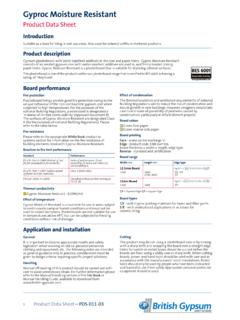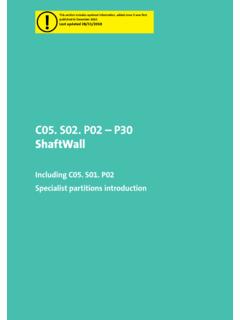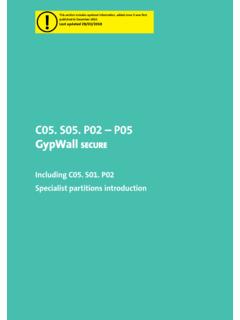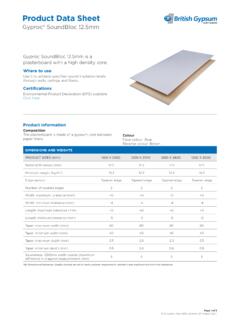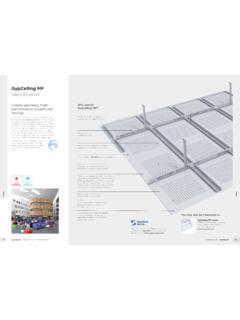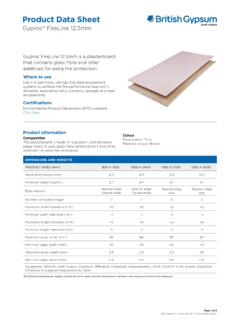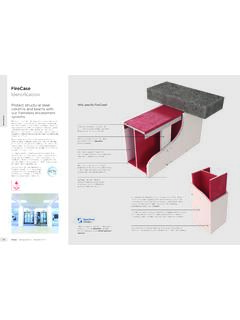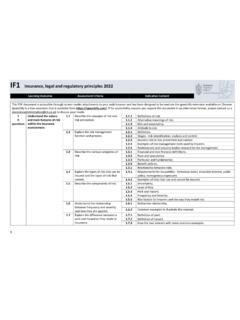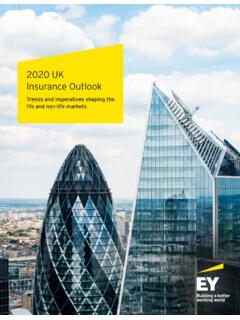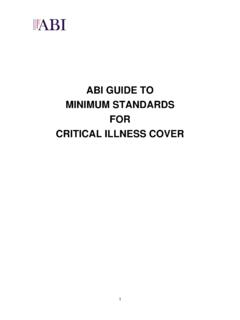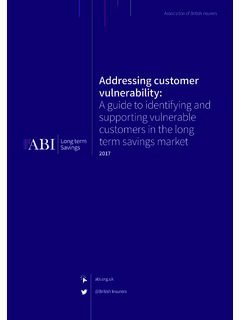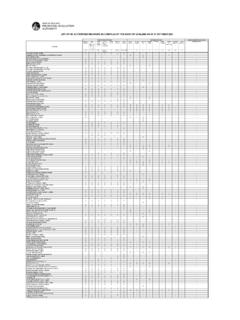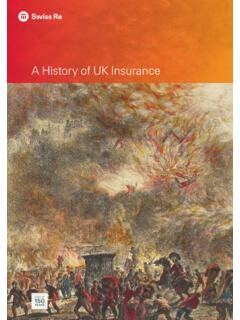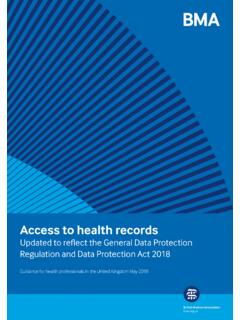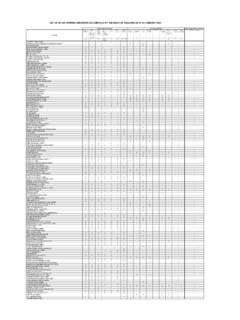Transcription of Robustness SYSTEM DESIGN PRINCIPLES - british-gypsum.com
1 This section provides guidance on the PRINCIPLES of SYSTEM DESIGN . Reference is made to relevant regulatory requirements and International Standard Organisation (ISO), European (EN) and british (BS). SYSTEM DESIGN PRINCIPLES SYSTEM DESIGN PRINCIPLES standards. It considers various PRINCIPLES from a building theory and practical perspective. Fire Service installations Fire performance includes fire Drylining elements need to be fully resistance, fire protection and compatible with building services reaction to fire, which are relevant such as electrical, plumbing, for compartmentation, structural heating and ventilation etc. This steelwork and surface spread of means that service installation flame respectively. british Gypsum should be fully assessed at the only test solutions to the most up DESIGN stage to ensure that the to date BS EN test standards.
2 Layout of the services is compatible Our technical specifications, with the ceiling module or location detailed drawings and technical of stud work. Furthermore, the advice is based on the latest weight of fixtures and fittings must BS EN test standards. BS 476 Parts be considered at the DESIGN stage 20-23, while accepted in AD-B for to ensure that the appropriate maintaining older buildings, is not SYSTEM with correct detailing is recommended for new or future specified. See page schemes. See page Acoustics Thermal insulation Building acoustics includes both Thermal comfort within a building sound insulation (airborne and is primarily dictated by the thermal impact) and sound absorption. insulation (heat loss), airtightness, A key DESIGN aspect is how the heating regime and ventilation, drylined building element interacts together with appropriate with the associated structure.
3 If vapour control to reduce risk of this is ignored, the performance condensation. Carbon dioxide of the element can be completely performance and fabric energy nullified. The key factors that are efficiency are measures used to covered include gap sealing, why optimise the performance of a it is preferable to take the partition building. See page through to the structural soffit, and why it is important to DESIGN out flanking sound transmission. See page Robustness Consideration needs to be given to the Robustness of drylining systems, particularly if required SYSTEM DESIGN . to resist crowd pressure, impacts, abrasions and wind loading. The stiffness of a partition is critical to this and is therefore PRINCIPLES . considered when determining the recommended maximum height. See page SYSTEM DESIGN PRINCIPLES / / SYSTEM DESIGN PRINCIPLES Fire Fire SYSTEM DESIGN PRINCIPLES SYSTEM DESIGN PRINCIPLES SYSTEM DESIGN PRINCIPLES SYSTEM DESIGN PRINCIPLES Legislation, guidance and insurance standards with the recommendations of the insurance Structural fire precautions Structural behaviour of steel in fire industry.
4 It also gives guidance regarding how fire Steel generally begins to lose strength at temperatures Building Regulations Fire safety protection measures can be used to augment passive Premature failure of the structure can be prevented by fire above 300 C and eventually melts at about 1500 C. Building Regulations Approved Document B (AD B) protection. protecting loadbearing elements. Importantly for DESIGN , the greatest rate of strength loss is and Technical Handbook (Fire - section 2) are a series in the range of 400 C to 600 C. Fire protection for structural steel in buildings, The purpose in providing the structure with fire of approved documents that provide practical guidance association for Specialist Fire Protection (ASFP) resistance is: Using fire DESIGN codes such as the Structural Eurocodes on meeting the fire safety requirements of the Building Yellow Book and (designated BS EN 1993-1-2 and Regulations 2000 (England and Wales) and Building To minimise the risk to the occupants, some of whom Publication prepared by the ASFP.)
5 Presenting the theory BS EN 1994-1-2), the load on the structure at the time of (Scotland) Regulations 2004 respectively. may have to remain in the building for some time behind, and methods for, fire protection of structural the fire can be calculated by treating it as an accidental (particularly if the building is a large one), while The documents are divided into two parts, AD B Volume steelwork to comply with Building Regulations. It provides limit state. If used, this will allow designers to specify to the evacuation proceeds 1 and Technical Handbook Domestic (Fire - section 2) a comprehensive guide to proprietary materials and fire protection contractor a limiting or failure temperature covers dwelling houses and AD B Volume 2 and Technical systems, all of which are manufactured, marketed by To reduce the risk to fire fighters engaged on search and for a given structural section.
6 The fire protection contractor Handbook Non-Domestic (Fire - section 2) covers members of ASFP. rescue operations will then be able to use the required thickness of material buildings other than dwelling houses. to ensure that the steel section does not exceed this To reduce the danger to people in the vicinity of the The documents classify the use of a building into purpose PRINCIPLES of fire performance building who may be hurt by falling debris, or because of temperature within the fire resistance period. This process could be simplified by the designer specifying a maximum groups and specify minimum periods of fire resistance the impact of the collapsing structure on other buildings Fire growth steel temperature, based on the worst case, for all beams or to be achieved by the building elements. The periods of The choice of materials for walls and ceilings can Fire limit state columns on one floor level.
7 Fire resistance vary according to the use and the size of significantly affect the spread of fire and its rate of growth, In structural DESIGN terms, fire is considered to be an building. The greater the fire hazard a building presents, Buildings that are not primarily used for storage, even though they are not likely to be the materials first accidental limit state, an accidental occurrence, and one then the greater the period of fire resistance required to offices, residential units, schools and hospitals, have a ignited. The specification of linings is particularly important for which the structure must not collapse. Loads and their protect the elements within the building. The materials high percentage of non-permanent loads. For this type of in circulation spaces where surfaces may offer the main factors of safety used in DESIGN at the fire limit state reflect used to form the internal surfaces of the building are also building, the structural Eurocode BS EN 1991-1-1 assumes means by which fire spreads, and where rapid spread is the low probability of occurrence.
8 Controlled to reduce the risk of fire growth and internal fire that a proportion of the DESIGN load will not be present most likely to prevent occupants from escaping. spread. Typically, structural members that are designed to be fully at the time of the fire. Other types of buildings, such as Two properties of lining materials that influence fire stressed under normal conditions would be subject to a warehouses and libraries, are primarily used for storage, Healthcare buildings spread are: load ratio of to under fire conditions. Within this so a high percentage of the load is permanent. The codes Hospitals and healthcare environments by their very nature book, loadbearing floors and partitions are quoted with allow for no reduction in DESIGN load for the fire condition. contain people who are at risk from fire. Health Technical The rate of flame spread over the surface when it is subject to intense radiant heating respect to a stated load ratio.
9 Many constructions have Memorandum (HTM) 05 series (England and Wales) and The fire testing standards effectively base the failure criteria been tested at a conservative load ratio of (100%). Scottish Health Technical Memorandum (SHTM) 81 series for loadbearing elements on strength. However, beams The rate at which the lining material gives off heat despite the fire state being an accidental load. documents cover the fire safety DESIGN of healthcare should be designed at the fire state limit as well at in the when burning facilities. These documents provide guidance on the Structural behaviour of timber in fire cold state limit. standards of fire safety expected in healthcare facilities and Compartmentation Timber has a low thermal expansion coefficient, which Columns are frequently designed so that a single length include recommendations on internal fire spread, elements The spread of fire within a building can be restricted by minimises the possibility of protective layers and charred will be two or three storeys high.
10 The lowest storey will of structure, compartmentation, fire hazard areas, hospital sub-dividing it into compartments separated from one materials becoming displaced. It also has a low thermal be loaded; the highest and the upper storey will be lightly streets, penetrations, protected shafts, ceiling membranes, another by walls and/or floors of fire resisting construction. conductivity, which means that undamaged timber loaded. In buildings with a degree of non-permanent load cavity barriers and fire-stopping. immediately below the charred layer retains its strength. The two key objectives are: (in terms of duration and magnitude), the load ratio of the Generally, it may be assumed that timber will char at a Educational buildings structural members is unlikely to be greater than In To prevent rapid fire spread, which could trap occupants constant rate when subjected to the standard heating The DESIGN of fire safety in schools is covered by Building storage buildings, where the majority of load is permanent, within the building conditions of the test furnace.
